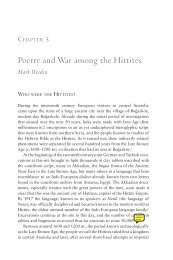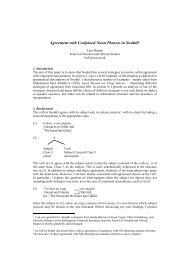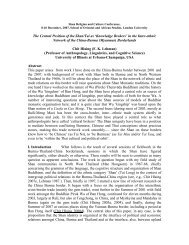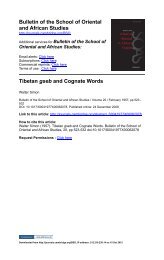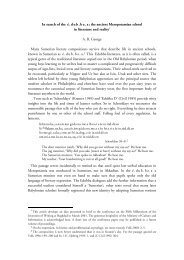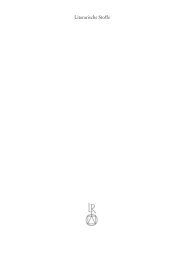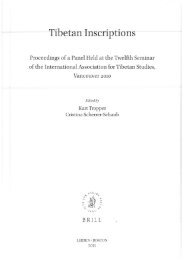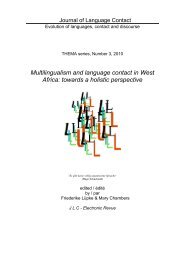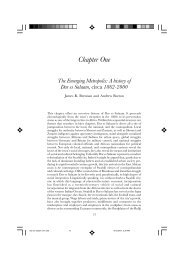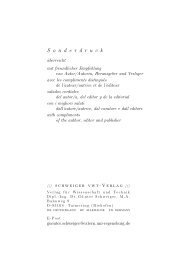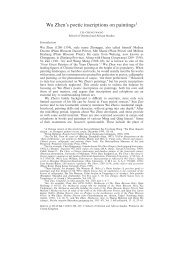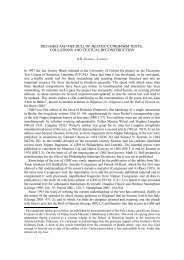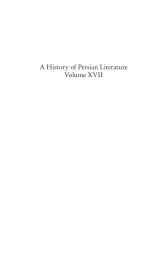Download
Download
Download
Create successful ePaper yourself
Turn your PDF publications into a flip-book with our unique Google optimized e-Paper software.
RENATE SÖHNEN-THIEME<br />
[[Contents<br />
Introduction<br />
List of abbreviations<br />
Marsiyas in Balti poetry<br />
The content of the Marsiyas<br />
Balti Marsiyas in Arabic script<br />
The language of the Marsiyas<br />
The poetic form of the Marsiyas<br />
The Marsiyas: text and translation<br />
Glossary<br />
List of names occurring in the Marsiyas<br />
Bibliography ]]<br />
Six Balti Marsiyas<br />
INTRODUCTION<br />
In 1980, I was offered the opportunity to take part in an expedition to Baltistan, which was<br />
organized by the Department of Central Asian Studies of the University of Bonn and financed by the<br />
Deutsche Forschungsgemeinschaft. Its aim was to collect different versions of the ancient Tibetan epic<br />
of King Kesar of Ling, but during my stay in Islamabad and Skardu I became interested also in other<br />
traditions of Balti literature, including lyrical forms like the traditional Balti ‘folksongs’ (rgyang-xlu),<br />
which are transmitted orally, as well as forms of traditional Islamic poetry, such as Qasidas and<br />
Marsiyas, which are now appearing in print. Thus I was able to obtain, in the only bookstall of the – at<br />
that time still quite rural – bazaar of Baltistan’s capital Skardu, a recently printed book named Xaz!rat<br />
al-Buk", containing more than 300 Marsiyas and Nohas by various Balti poets of the last two<br />
centuries.<br />
On my return to Rawalpindi I showed this book to Wazir Himayat Husein, at that time Balti<br />
Producer of Radio Pakistan Rawalpindi, with whom I had already established a good collaborative<br />
relationship at the beginning of my stay in Pakistan, before travelling to Baltistan. He was greatly<br />
pleased that I was taking an interest also in this aspect of Balti literature which, according to his<br />
feeling, was far more cultivated than the ‘pagan’ story of King Kesar. He provided me with a tape<br />
cassette on which were recorded four Marsiya recited by the renowned contemporary Balti poet Fed!<br />
Husein ‘Sham"m’. He also invited Balti artists of Radio Pakistan to perform Islamic forms of poetry for<br />
my benefit, amongst them the recitator Muhammad Reza, a serious young man from whom I was able<br />
to record one Qasida, two more Marsiyas, and one Noha. During the rest of my stay in Rawalpindi I<br />
transcribed, with the help of Wazir Himayat Husein, all these recordings and started to translate them<br />
into English, but time was to short to complete the work properly.<br />
It was not until spring 1987, when I spent five weeks in Skardu in order to continue my work on the<br />
transcription of the Kesar epic, that I was able to return, be it only for a short time, to work on the Balti<br />
Marsiyas. They were again discussed with Wazir Himayat Husein, so that the translation of the six<br />
Marsiyas presented in this article could be completed. In summer 1989, I prepared a first draft,<br />
including text and translation, list of names, vocabulary, and starting with reflections on a workable
transcription system for the Balti text in Arabic script. This will now, after a long interval, be presented<br />
in a corrected form in the following pages.<br />
The six Marsiyas are given in the sequence in which they were transcribed them (not in a<br />
chronological or otherwise systematic order), starting with the two Marsiyas recorded from<br />
Muhammad Reza, who recited them from a printed text, probably the same version as the one that was<br />
printed in Xazrrat al-Buk", since there are hardly any variants. They are followed by the four Marsiyas<br />
sung by Feda Husain Šam"m, in the order in which they were recorded. Here my transcription<br />
represents the recorded (oral) version, with variants from the printed text in footnotes. The first four<br />
couplets of Marsiya no. 3 are also published, together with a musical transcription, in my article ‘Music<br />
in Baltistan’ (1993).<br />
List of abbreviations<br />
abl. ablative<br />
adj. adjective<br />
adv. adverb<br />
aor. aorist<br />
Arab. Arabic<br />
BPhR RANGAN, Balti Phonetic Reader<br />
det. determinative<br />
erg. ergative<br />
fut. future<br />
gen. genitive<br />
inf. infinitive<br />
intr. intransitive<br />
lit. literally<br />
loc. locative<br />
part. participle<br />
pass. passive<br />
Pers. Persian<br />
pl. plural<br />
postpos. postposition<br />
pres. present tense<br />
pret. preterite tense<br />
RBG C. F. R. READ, Balti Grammar<br />
s.th. something<br />
s.o. someone<br />
trans. transitive
Marsiyas in Balti poetry<br />
Besides the Qasidas, which are in Balti poetry exclusively dedicated to topics relating to the Holy<br />
Prophet and his family, it is the poetic form of Marsiyas which seems to have been especially popular<br />
with Balti poets, perhaps because this genre gave them some scope to express deep feelings that were<br />
not connected with more or less trivial personal grievances or ‘sinful’ experiences of personal love, and<br />
were therefore legitimate and highly appreciated,<br />
‘Under the influence of strict adherence to the religion, Baltistan!s poets have not given attention to<br />
the side of other genres of poetry, since, apart from the recitation of Marsiyas and the praise of the<br />
Holy Prophet and his noble family, other poetic genres like the ghazal are regarded as sin. Therefore<br />
ghazals are scarce with high-ranked poets of the Balti language.’ 1<br />
Regrettably, the tradition of Marsiya composition cannot be traced further back than the first half of<br />
the 19th century. It seems to have been kept up basically by members of the ruling families, the Rajas<br />
or Khans of Skardu etc., but here are also poets belonging to Sayid or #khund families.<br />
The first and most prominent Balti poet is Raja Husein Ali Khan ‘Muhibb’, a son of Shah Ahmad<br />
Maqpon, the last independent Balti ruler of Skardo, who was forced to surrender by the Dogras in<br />
1840 and was led into exile, together wih his family. Possibly it was this experience of humiliation and<br />
captivity which made the form and topic of Marsiyas so attractive to Muhibb and other poets in his<br />
family. Muhibb is the author of the Marsiyas no. 3 and 4 (performed by Feda Husein ‘Šam"m’ on the<br />
tape cassette recording that I transcribed).<br />
There is some doubt about Muxlis (or Mokhlis): according to my friend Wazir Ghulam Mahdi (a<br />
retired lawyer who gave me valuable information about Balti traditions), the name Mukhlis was a pen-<br />
name of Muhibb at an earlier stage of his life. In this case Marsiya no. 6 would have to be considered as<br />
earlier then no. 3 and 4. Afridi and Kal"m seem to be convinced that he was a brother of Muhibb,<br />
presumably a younger brother, since his name is listed later than that of Muhibb in both sources<br />
(Afridi p. 166, Kal"m p. 45); this would change the chronological order suggested by Wazir Mahdi.<br />
There is, however, only one Marsiya ascribed to ’Mukhlis’ in the volume of Xaz"rat al-Buk!, and it is<br />
this same Marsiya from which he first four couplets are quoted by K!lim (who adduces, as an example<br />
for Muhibb, a Marsiya not printed in Xaz"rat al-Buk!); so one may wonder whether he wrote anything<br />
else (or why he gained so much renown for only one poem), or whether he was indeed different from<br />
Muhibb. It is also interesting that for the Marsiyas 4 (Muhibb) and no. 6 (Mukhlis) the printed edition<br />
differs from the recitation of Feda Husein Šam"m, adding two couplets to no. 6, and replacing one<br />
couplet by two others in no. 4. 2 My friends Wazir Ghulam Mahdi and Wazir Himayat Husein were<br />
convinced that more credence should be given to the well-established oral tradition, as presented, e.g.,<br />
by the recitation of Feda Husein am"m.<br />
As for Z!kir, he represents the next generation after Mu$ibb/Mukhlis, being introduced as a<br />
nephew of Mu$ibb by Afridi. He still belongs to the first period of Balti poetry as identified by Afridi<br />
1 S. ‘A!!! "usein KAL"M, Baltist!n k# Š!‘ir#, p. 44, my transl.<br />
2 There are a considerable number of different wordings in the printed text and the recitation of<br />
Marsiyas no. 3 and 4; these deviations seem also to bear witness to the age and popularity of the<br />
poems.
and Kal"m. For the intermediate period I have no example. The modern period is represented with one<br />
example, no. 5, by Fida Husein Šam"m of Khapulu, who has published, apart from poetry on<br />
traditional topics, also a famous satirical poem criticising certain modern habits (Y" z"m"ni# tho#!<br />
‘Look at these times!’).<br />
The content of the Marsiyas<br />
As is well known, the genre of the Marsiyas is defined by its topic: they reflect the tragic events of<br />
the batle of Karbala in the month Mu$arram in 680, when %usein, the grandson of the prophet<br />
Mu$ammad, following an invitation from the inhabitants of Kufa, was confronted on his way, in the<br />
desert, with an overwhelming force sent by Yaz"d’s newly appointed governor of Kufa, Ibn Ziy!d. He<br />
demanded that %usein should surrender and acknowledge Muz‘!fiya’s son Yaz"d as caliph. %usein<br />
refused, which put him into the position of a rebel against the established power and justified, in their<br />
eyes, the scandalous treatment of the last grandson of the prophet. %usein was accompanied only by<br />
the members of his family, including women and children, and a small group of his faithful followers.<br />
There was no chance of a favourable outcome. In the afternoon of the 10th Mu$arram all his followers<br />
and his grown-up male family members, including himself, were killed in battle. Their bodies were left<br />
unburied, trampled on by the enemies’ horses; their heads were cut off and put upon spears, to be<br />
taken to Kufa on the second day after the battle, together with the women and surviving children, who<br />
had been the witnesses of the slaughter; later they were led to Damascus and presented to Yaz"d.<br />
The outrageous cruelty of these events has remained burningly vivid in the memory of the Shi!a<br />
community, who feel that they have to suffer themselves, in order to make up for the sufferings of the<br />
martyrs and to be worthy of them. In Baltistan this tradition has remained strong up to the present<br />
day: 3 every year during Mu$arram the martyrs are celebrated by processions and congregations, in<br />
which their cruel fate is lamented, and young men (like my informant S. M. Abbas Kazmi) are proud of<br />
the wounds they have inflicted on themselves by beating themselves and even cutting themselves with<br />
knives.<br />
In the Marsiyas published in this article the events of Karbala are presented from different angles:<br />
the most modern one, by Šam"m, narrates how the surviving family of Husein is led away from the<br />
place where their relatives were killed, whereas the second Marsiya of Mu$ibb and the two Marsiyas of<br />
Z!kir are put in the mouth of one of the women, %usein’s sister Zainab, with only one or two couplets<br />
introducing the speaker and her situation. The first poem of Muhibb introduces ‘Ali Akbar’s mother<br />
reporting his death to his sister, Husein!s daughter F!tima on her arrival in Damascus; and the last<br />
Marsiya, by ‘Mokhlis’, concentrates on Sakina, the two-year-old daughter of Husein, who died on the<br />
way to Damascus.<br />
3 cf. U. Sagaster 1989.
Balti Marsiyas in Arabic Script<br />
The Arabic script, which was not quite suitable even for the Persian language, is still less suitable<br />
for the Urdu language, which needs a distinction between the long vowels ! and -e and the diphthong ei<br />
as well as between $ and -o and the diphthong ou on the one hand, between aspirated and non-<br />
!spirated consonants on the other. Even less suitable is this script, naturally, for the Balti language, an<br />
unwritten West-Tibetan dialect, with its consonant clusters, especially at the beginning of a word. Yet<br />
there is justification enough for writing Balti Marsiyas in that script, since there are many loan-words<br />
from the Persian and the Arabic languages; the names of the martyrs of the battle of Karbala are, of<br />
course, all Arabic, so that about fifty percent of the words occurring in the Marsiyas are quite correctly<br />
written in the Arabic script. As for the Balti words, however, even educated native speakers of the Balti<br />
language sometimes find it difficult to recognise them at once in the disguise of the borrowed Arabic-<br />
Persian script. But since, on the other hand, the Tibetan script would not fit for the Arabic and Persian<br />
loanwords at all, and since attempts of inventing a special script for the Balti language (cf. S. SCHULER,<br />
‘The "Story of the Creation of Shigar of Wazir Ahmed’, in Central Asiatic Journal 22, 1977, p. 102-119)<br />
have been modeled after the system of the Arabic-Persian script (with all the deficiencies concerning<br />
the vowel system), it will be the best compromise for the Baltis to keep to the Arabic-Persian script, the<br />
more so as it is the script of Urdu, the official language of Pakistan.<br />
As for the Roman script, people of the South-!sian subcontinent came to know it through English,<br />
which is, as far as the representation of vowels is concerned, extremely ambiguous and unpredictable;<br />
thus it is small wonder that people of the subcontinent (who are normally used to a more or less<br />
strictly phonetic orthography for their languages) get confused in using the Roman script for their<br />
languages. Had they come to know it directly from Latin, Italian, or even from German, they could<br />
have used it for phonetic transcriptions, adding some diacritical marks to some letters, in order to<br />
distinguish the consonants not contained in the Roman alphabet. At least, the vowels could have been<br />
represented in an unmistakable way.<br />
As matters stand, one has to try to develop a workable transcription system and to explain it again<br />
on each occasion one wants to work with it. Therefore I shall now give my attempt of combining<br />
Arabic-Persian and Balti (Tibetan) elements in one transcription system.<br />
On principle, I shall try to present one letter of the Arabic-Persian script, in which the Balti<br />
Marsiyas are written, by one letter of the Roman script, using diacritical marks for sounds that are not<br />
represented in the Roman alphabet. (Except for the aspirated sound and the voiceless l and r, this<br />
principle is also observed by the Arabic-Persian transcription.) This is the main deviation from the<br />
commonly used systems which are generally more influenced by the English transcription of<br />
consonants. Thus my transliteration deviates, to some extent, from the transcription system adopted<br />
by A. F. C. READ (Balti Grammar, London 1934) for the Balti language; it deviates only slightly from<br />
the Urdu alphabet as given by PLATTS in his Urdu-English dictionary (first published in Oxford, 1884).<br />
It is influenced by the transcription system used for Iranian languages (for instance x, %, š, ž) and for<br />
the Sanskrit (j and the nasal #). The result is, of course, only a compromise, but seems to me the best<br />
solution for the moment.
Last but not least, I have to point to the fact that the text printed in the Arabic script is in itself not<br />
always consistent in its representation of Balti sounds (e.g. $ # may be also written as % # , and the<br />
aspirated sound kh- may appear as " ! as well as ' & , etc.)<br />
A. The consonants of Balti in Urdu script<br />
voiceless aspirated voiced<br />
( k "# kh ) g<br />
$ q % x (RBG kh) & & 4 (RBG g)<br />
' t "( th ) d<br />
* p "+ , ph 5 - b<br />
. ' (RBG ch) "/ , 'h (RBG cch) 0 j (* ž)<br />
1 6 ( (RBG ts) 21 (h (RBG tsh)<br />
3 š (RBG sh) [0] ž (RBG -j)<br />
4 s 5 z<br />
+ ' hl (mainly before voiceless consonants) 6 l<br />
, ' hr (only before voiceless consonants) 7 r<br />
Nasals:<br />
8 m 9 n<br />
) - , initial # ) (RBG ng)<br />
Half vowels:<br />
: w ; y<br />
' h<br />
Retroflex sounds:<br />
< * = +<br />
B. Written vowels<br />
> , initially ? ! (long)<br />
4 pronunciation of q between vowels.<br />
5 In spite (or because) of the fact that @ is used both for Arabic-Persian f and Balti ph (which is<br />
fricated in some Balti dialects, I decided to distinguish between both in my transcription: in Balti<br />
words I use ph, in Arabic-Persian words f.<br />
6 redefined as in Kashmiri, not as in Persian, where it denotes ž.
; , internally . i (short) and " (long)<br />
A, internally . e [,] or [,:]<br />
DE BC (loc. ending) e) [e:-]<br />
: u (short) or . (long) and o (long, except in Persian -o "and")<br />
Short vowels are sometimes not written within the word, especially short a, which is written as /<br />
(alif) initially and with F at the end of a word (e.g. the particle GH na "from, and, after", the dative<br />
particle GI la, etc .).<br />
C. Consonant clusters<br />
Since short vowels are normally not written, and since, on the other hand, absence of a short vowel<br />
is not indicated (e.g. by a suk.n, as in the notation of the Qur‘!n), it is sometimes difficult to guess<br />
whether a group of consonants must be read as a consonant cluster or not. In a Tibetan language or<br />
dialect, such consonant clusters are to be expected especially at the beginning of a word. The following<br />
are typical initial consonant clusters:<br />
JK# khr- . "# khy-<br />
JL gr- . 0 gy- MN gw-<br />
. # )y- . 1 'y- . 2 šy-<br />
JO tr- 7) dr- PB , p+-<br />
JK + , phr- . "+ , phy- 3 "+ , phs-<br />
JBQ br- . 4 by-<br />
6 5 &d- RS &z-<br />
8 7 xl- 9 7/<br />
3 7 / 3 : xs-<br />
; 8'<br />
hlt- < 8'<br />
hl'- = 8'<br />
hl(-<br />
& , ' hrk- . &,<br />
' hrky- > , ' hrt-<br />
? , ' hr(- @ ? , ' hr(ya- A , ' hrm-<br />
0 B rg- . 0B<br />
rgy- 4 B rb-<br />
)7 rd- )5 zd- 0 C zg-<br />
E D sk- . ED<br />
sky- F D sp-<br />
G D sm- - D sn-/s)<br />
J TU st- J TU str-<br />
D. Consonants only used in Arabic/Persian loanwords and names (mainly in accordance with Platts’s<br />
system):<br />
V %-s<br />
W $<br />
X /
Y 0 Z 1<br />
[ %::t \ %::z<br />
] ‘ (Ain)<br />
@ f<br />
^ ’ (Hamza)<br />
E. Inventory of signs and their transcription in the order of the Urdu alphabet:<br />
> a, !<br />
- b<br />
* p<br />
' t _ 2<br />
"( th "` 2h<br />
V %--s<br />
0 j, ž (RBG j, %-j)<br />
. ' ( " ch)<br />
"/ , 'h ( " cch)<br />
W $<br />
% x<br />
) d<br />
< *<br />
X /<br />
7 r<br />
= +<br />
5 z<br />
1 ( (RBG ts 7 )<br />
21 (h (RBG tsh)<br />
4 s<br />
3 š (RBG sh)<br />
Y 0 Z 1<br />
[ %::t \ %::z<br />
] ‘ (Ain)<br />
7 This sign seems to be derived from the Kashmiri usage, rather than from the Persian.
& & (RBG H)<br />
@ f, ph<br />
$ q<br />
( k<br />
"# kh<br />
) g<br />
6 l<br />
8 m<br />
9 n, ) (RBG n, ng)<br />
: w, u, ., o<br />
F h<br />
, ' hr<br />
+ ' hl<br />
; y, i, ", e, ei<br />
; a I (in Arabic names only) a<br />
^ ’ (Hamza)<br />
The alphabetical order used in the Glossary is that of the Roman alphabet, with the following<br />
exceptions: all vowels appear before the consonants; non-aspirate and aspirate voiceless consonants<br />
are listed separately, the aspirates following the non-aspirates. The order is as follows:<br />
a e i o u; ba be bi bo bu (etc.), bd bg bl br by bz; & &h, % %h; d dr dy '; f; g gr g( gw gy, ), )b )d )z; h hl<br />
hr; j; k kh khr/kh( khy; l ld ly lz; m my; n, # #y; p pl, ph ph% phl phr phy; š; t tr ty, th th( thy, * *h *hr;<br />
w; x x% xl xm xn xp xs xt xy; y; z zb zd zg, ž, +.<br />
The language of the Marsiyas<br />
For the Balti language in general, READ!s grammar is the basic tool, which has recently been more<br />
systematically treated and improved by the "Descriptive investigation on the grammar of Balti<br />
according to the orally transmitted text..." (Part 3 of R. BIELMEIER’s "Das Märchen vom Prinzen<br />
3obza)" St. Augustin 1985), in which the results of other books and articles have also been included.<br />
As for the special language of the Marsiyas, two especially striking features have to be considered:<br />
(1) the large number of words and even short phrases taken over from the Persian language, which is<br />
in different ways interwoven with the Balti grammar and vocabulary;<br />
(2) the fact that in poetic texts the word-order is not strictly observed, which makes it sometimes very<br />
difficult to construe meaningful sentences. It was quite hard for me as well as for my Balti informant
Wazir Himayat Husein to come to an understanding (and translation) of the texts that was satisfactory<br />
for both sides. (For the trouble he had to suffer due to my merciless curiosity I owe him special<br />
thanks.)<br />
Arabic and Persian elements in the Balti Marsiyas<br />
As one would expect, most of the words taken over from Arabic and Persian are nouns and names<br />
of persons and places (they may be looked up in the respective glossaries). They are grammatically<br />
treated like other Balti words; they take case and plural endings, and determinative and derivative<br />
suffixes.<br />
Apart from the unmarked direct case, the following (oblique) case endings are found:<br />
Genitive: Yaz!di 1.2a, %::zulmi 1.6a, ummati 1.6b, dušmani 1.7b; 5.7b; 6.2a, Huseini 2.7a, Akbari 3.5b,<br />
Hašimi 5.1b, Zahr"i 5.2b, Zeinabi 5.6a; im"mi 6.1a, mahšeri 6.6a.<br />
Ergative: Sakin"si 1.5a, Zeinabi 2.3a; 4.1a, Šimrisi 2.8a, Šimiri 2.9b, xud"s 4.3a, Šimri 4.4a, Zeinabisi<br />
5.4b; 5.5a, Muxlisi 6.6a.<br />
Locative (a) with -"# or -"#nu: Kurbo-bal"yi#nu 1.1a; 5.6a, Dimišqe# 1.2a, šafa)i#nu 1.2b (šafaq),<br />
ha)i#nu 1.7b (haq), Š"mi# 1.4b; 3.1a; 5.7a, Najafi# 4.1a.<br />
(b) with gen. and -kha: nezikha 2.7b; 3.5b, %::zulmikha 3.2a, duny"dikha 6.4b.<br />
Any postposition can, of course, be placed behind any Arabic or Persian word (such as la for the<br />
indirect object, etc.).<br />
As BIELMEIER in his study has pointed out (e.g. p. 82, on the suffix of nominal determination),<br />
Arabic and Persian loanwords can easily take the suffix of nominal determination, -po:<br />
d")po 1.3a, sarpo 1.5b; 2.7a, ‘ezzatpo 2.6b, "lampo 3.3b, duny"dpo 3.4a, tanpo 4.2a, sa’atpo 4.7a,<br />
Huseinpo 4.3b.<br />
Likewise names of places can also take the derivative suffix -po, forming adjectives with the meaning<br />
"belonging to". Examples:<br />
š"mpo#i (gen. pl. of š"mpo "belonging to Syria") 1.1a; kufa-na-š"mpi (gen.) 1.6a "belonging to Kufa<br />
and Syria"; š"m-kufapi (gen.) 2.7b; š"m-kufapo#i (gen. pl.) 3.2a.<br />
Examples of plural forms (suffix -kun):<br />
‘odkun 1.6a, nezo#i (gen. pl.) 1.5b, sarkun 2.1b, penjyu# 3.6a, jaw"nkun 5.1b, burqa-daxonkun 5.3a.<br />
The plural form ending in the suffix -" in penjy" (3.6b), which presumably corresponds to the Persian<br />
suffix -h", appears also in Balti words in Marsiya no. 2: khabu" "flower-buds" (sg. khabu) 2.2b;<br />
stri#mo" "sisters" (sg. stri#mo) 2.4a; and perhaps in stanza 1: s#ya-zgo", rba-zgo".<br />
As for other word categories taken over from Arabic and Persian, I noted the following few<br />
examples:<br />
(a) numerals: haft"d-o-du 4.2a "72",<br />
(b) adverbs: al-qissa 1.2a "in short",<br />
(c) prepositional adverbs (alien to the Balti language): bar$ 1.2a; 2.1a "towards".<br />
Some phrases are taken over as a whole, especially Izafat-constructions. Examples:<br />
"l-e ras$l 1.1a, ahl-e haram 2.1a, šahr-e dimišqe# 1,2a nahr-e fur"t 2.5a, zeinab-e ‘uliy" 5.7a, ‘ab!d-e<br />
b!m"r 5.7b, names like Abu’l-Fazl-e ‘Al! 5.1a, ‘Abb"s-e ‘Al! 5.2a.
Other examples are closely connected word pairs, such as:<br />
be-)usl-o-kafan 1.4b; 5.6b, Zeinab-o Saj"d 5.1a, Q"sim-o Akbar 5.2a. – In this connection, it may be<br />
observed that these phrases are found far less in the Marsiyas by Mu$ibb (nos. 3, 4, 6) than in the<br />
other Marsiyas; but the material is not comprehensive enough to allow any generalisation.<br />
The only verbal composition with a Persian loanword is baxšiš byos (1.4a), which, however, seems to<br />
have become a fairly common Balti idiom, apart from the Marsiyas.<br />
The poetic form of the Marsiyas<br />
The Balti Marsiyas are generally composed in the form of )azals, consisting of a number of<br />
couplets, the first of which introduces a rhyme in its two lines, which is then taken up always in the<br />
second line of the following couplets. Thus, in Marsiya no. 6 the rhyme is -a#se Sak!na (bra#se, la#se,<br />
pha#se, )dya#se, dra#se, &ha#se, ga#se), the verbal ending in a#s(e) being quite common in the Balti<br />
language. Marsiya no. 4 has the rhyme -an %i (lan %i, hltakhan %i, byakhan %i, kafan %i, man %i bašan<br />
%i, sman %i, )dan %i). These two Marsiyas by Mu$ibb are perfectly in accordance with the rule. In no. 3,<br />
however, there is a slight deviation: the first line of the first couplet does not rhyme with the second<br />
line (and all other second lines), 8 and the rhyme -ure o#s na (khure o#s na, bure o#s na, skyure o#s<br />
na, ... skure o#s na 6) shows the variants store o#s na (4) and khere o#s na (5).<br />
Similar irregularities can also be found in the two Marsiyas by Z!kir. No. 1 uses, as rhyming<br />
syllables, -a)i#nu and -a#i#nu alternatively: la)i#nu – tha#i#nu; šafa)i#nu, hl%a)i#nu, than;i#nu<br />
(again), p(a#i#nu, kha)i#nu, la)i#nu (again), ha)i#nu. Marsiya no. 2 is still more irregular. The first<br />
two stanzas do not belong to the same rhyming scheme as the rest, which rhyme in -aled mi#mo<br />
‘alamd"r: yaled ..., kaled, skaled, thaled, kaled (again), &haled, kaled (again). Instead, the first couplet<br />
seems to introduce the rhyme -a-zgo", but the second couplet answers with qatilg"h, which does not<br />
fit in the scheme at all. It is difficult to decide whether this extremely weak rhyme really goes back to<br />
the author Z!kir; but considering also the repetitions within the rhymes, one might get the impression<br />
that the two Marsiyas by Z!kir are inferior to those by Mu$ibb, as far as the formal aspect is<br />
concerned.<br />
As for the Marsiya by the contemporary poet Šam"m, he seems to follow the rhyme of no. 1 (by<br />
Zakir), confining himself to -a)i#nu: hrma)i#nu, khra)i#nu, hl%a)i#nu, pha)i#nu, la)i#nu,<br />
khra)i#nu (twice again), hrma)i#nu (again). Thus the rhyme is pure, showing, at the same time,<br />
repetitions like those in the Marsiyas by Z!kir. An interesting feature in Šam"m’s Marsiya is, however,<br />
that its first and last couplet start with the same words, which may be taken as a deliberate device of<br />
composition.<br />
8 This may indicate that an original first couplet has been lost; when I discussed the translation and<br />
contents of the Marsiyas it did not occur to me to discuss the form as well and enquire about this<br />
particular feature.



